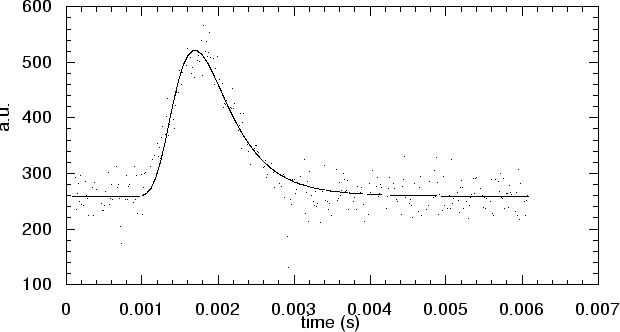 |
To examine the velocity distribution of the He* beam, we have performed a Time Of Flight (or TOF) measurement. First we stabilized the MOC laser with the saturation spectroscopy at exactly resonance (no magnetic field over the vapor cell). This resonant laser light is directed to the differential pump section with use of mirrors, and is shone in directly behind the diaphragm that we put in the He* beam (see fig 3.3).
The diaphragm only lets through a small part of the beam, which falls on the channeltron located 2.15 m behind the diaphragm. If the MOC laser is turned on, it will push away the He* atoms in the beam, so that they will not be detected by the channeltron anymore. This results in a dip in the channeltron signal.We now put a chopper in the laser beam. This chopper is a black circular plate with a 15 by 1mm hole in it. The plate can be turned around with a frequency up to 100 Hz. This causes the MOC laser to periodically push away the He* atoms for 5% of the time, and leave the atoms unaffected for the remaining 95% of the period. The chopper gives a trigger signal every time the laser passes through the hole in the chopper.
At the short moment that the MOC laser shines through the small hole in the chopper, all the He* atoms are pushed away from the center line of the setup. This will cause a dip in the signal at the time these He* should have reached the channeltron. The width and depth of this gap gives information on the spread in velocity of the He* beam.
 |
The distribution is expected to be a supersonic expansion
distribution due to the pressure gradient over the two sides of the
nozzle plate. In fig. 3.4 this dip has been inverted to
fit to the data points a supersonic expansion distribution [8]
of the form:
From this TOF measurement, we found that the mean speed of
the He* atoms leaving the source is ![]() m/s, with a velocity
spread of 378 m/s.
m/s, with a velocity
spread of 378 m/s.